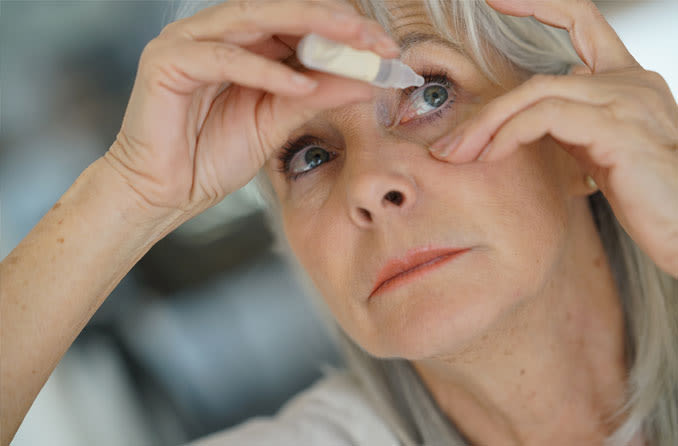Glaucoma treatment: Eye drops, medications and more

Most treatments for glaucoma are designed to lower and/or control intraocular pressure (IOP), which can damage the optic nerve that transmits visual information to the brain.
Glaucoma eye drops often are the first choice over glaucoma surgery and can be very effective at controlling IOP. If your eye doctor feels you are a good candidate for glaucoma eye drops, you may be prescribed more than one type to achieve the best IOP control.
Types of glaucoma eye drops
Glaucoma eye drops are classified by the active ingredient chemical that helps make the drug work:
Prostaglandins
These glaucoma eye drops often have the best user compliance because they are required only once daily. Prostaglandins generally work by relaxing muscles in the eye's interior structure to allow better outflow of fluids, thus reducing build up of eye pressure.
Possible side effects of prostaglandin eye drops for glaucoma include stinging and burning, eye colour change, and lengthening and curling of the eyelashes.
Beta-blockers
Used in a variety of glaucoma eye drops, beta-blockers were at one time the drugs of first choice in treating glaucoma. These drugs work by decreasing fluid (aqueous) production in the eye and now are often prescribed as an adjunct to or in combination with prostaglandins.
These eye drops have the potential to reduce heart rate and may cause adverse side effects in individuals with certain heart problems, lung problems (such as emphysema), diabetes, depression or other conditions. For these reasons, make sure you discuss your medical history in detail with your optician before using beta-blockers.
Alpha-adrenergic agonists
These drugs work by decreasing rate of aqueous humour production and can be used alone or in combination with other anti-glaucoma eye drops.
Common side effects associated with this classification of eye drop include red or bloodshot eyes (ocular injection), upper lid elevation, dilated pupils and itching.
Carbonic anhydrase inhibitors
These drugs work by decreasing rate of aqueous humour production. They are usually used in combination with other anti-glaucoma eye drops and not alone. This classification of drug is also used in oral form (pills). Common side effects experienced with carbonic anhydrase inhibitor (CAI) eye drop include burning, a bitter taste, eyelid reactions and eye redness.
About half of patients cannot tolerate oral CAIs due to their systemic side effects, which include fatigue, depression, loss of appetite, weight loss, loss of libido, kidney stones, metallic taste and tingling in fingers and toes (peripheral neuropathies).
Parasympathomimetics
These drugs work by increasing the outflow of aqueous humour from the eye. They are frequently used to control IOP in narrow-angle glaucoma. These eye drops cause the pupil to constrict, which assists in opening the narrowed or blocked angle where drainage occurs.
Common side effects experienced with these types of eye drops include brow ache, pupil constriction, burning, and reduced night vision.
Epinephrine
The epinephrine class of drugs has a dual effect on the eye. These drugs work by decreasing the rate of aqueous humour production and increasing the outflow of aqueous humour from the eye.
Common side effects experienced with this classification of eye drop include pigmented eye surface membrane (conjunctival) deposits, blocked tear ducts and heart palpitations with an increased heart rate.
Hyperosmotic agents
These drugs are usually for people with a severely high IOP that must be reduced immediately before permanent, irreversible damage occurs to the optic nerve. Hyperosmotic agents reduce IOP by lowering fluid volume in the eye.
Usually given only on a one-time, emergency basis, these drugs include oral glycerin and isosorbide orally, and mannitol and urea intravenously.
Combination glaucoma drugs
Many individuals with glaucoma require more than one type of medication to control IOP. For this reason, a few ophthalmic pharmaceutical companies have produced "combination" eye drops that can include two different anti-glaucoma medicines in the same bottle.
For convenience, your optician might prescribe combined IOP-lowering medications. Typically, these combined medications have the additive effect of reducing IOP.
Ask your optician
With all the different types of glaucoma medications available, it’s important to seek the care of an eye doctor who is experienced in glaucoma treatment to get the best type of medication for your particular needs.
Ask your optician to explain the type of glaucoma medication being prescribed, and why that treatment is best for you.
Page published on Wednesday, 26 June 2019






